India Map
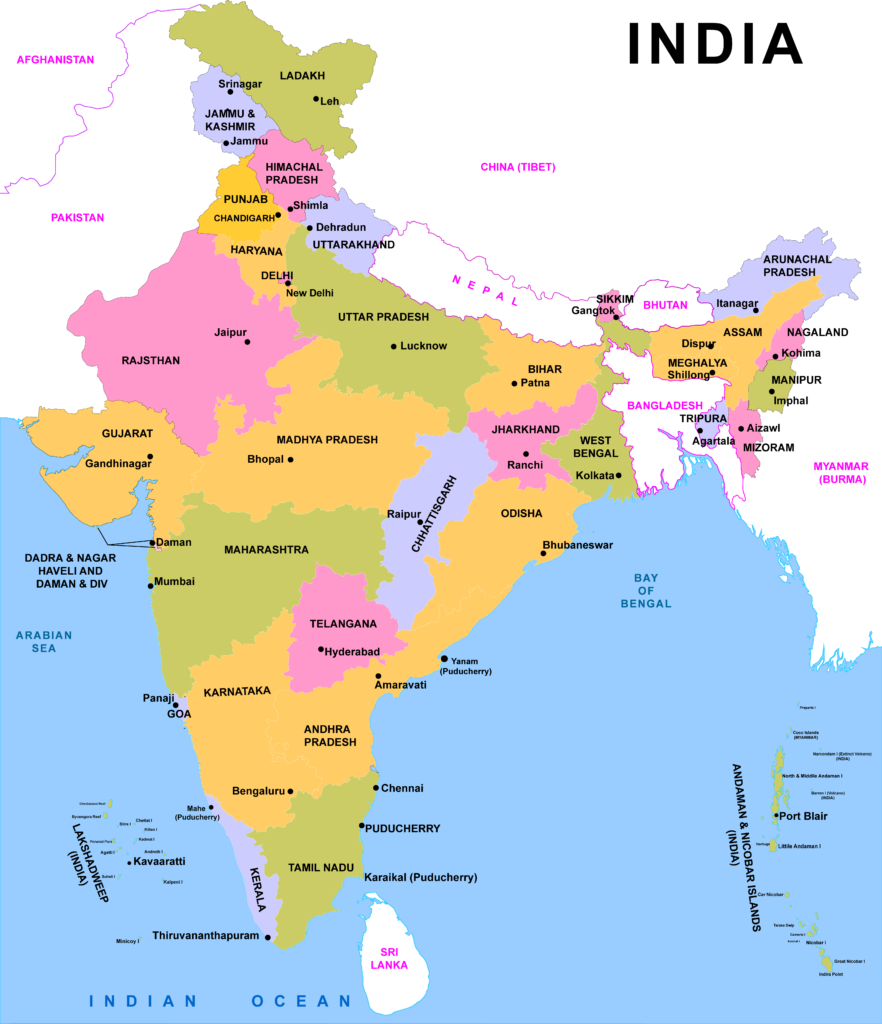
India Outline Map
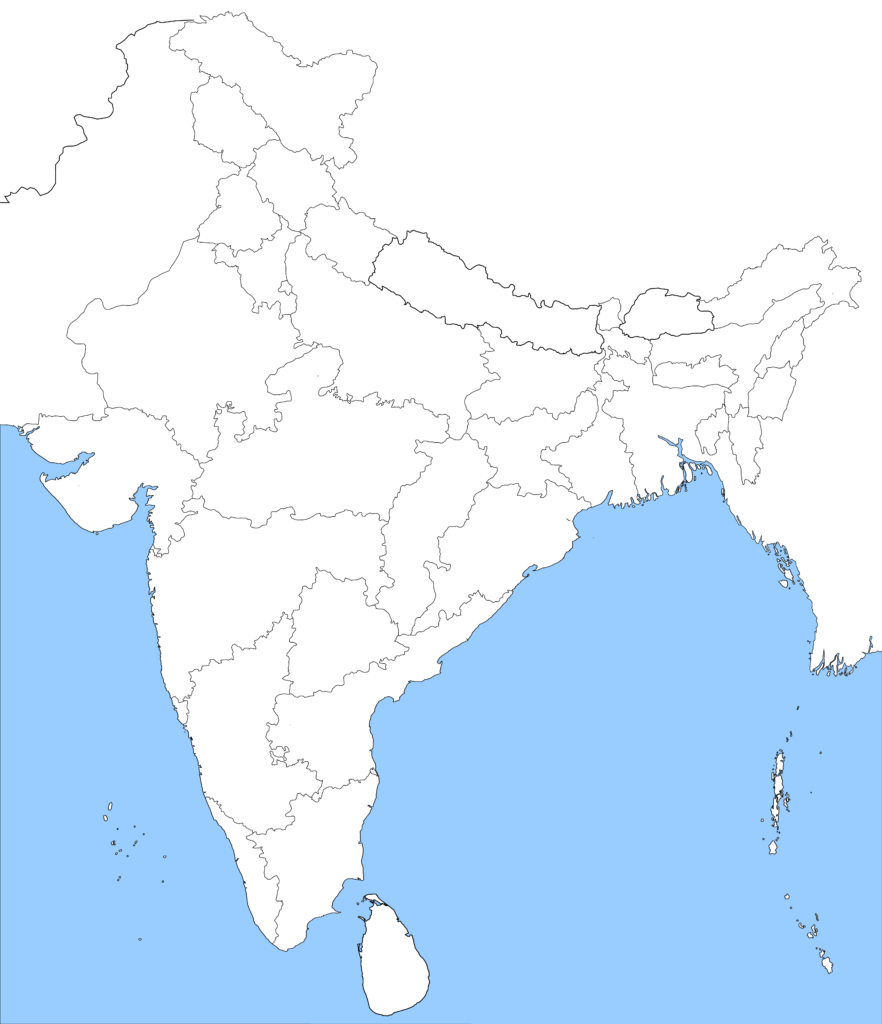
India Blank Map
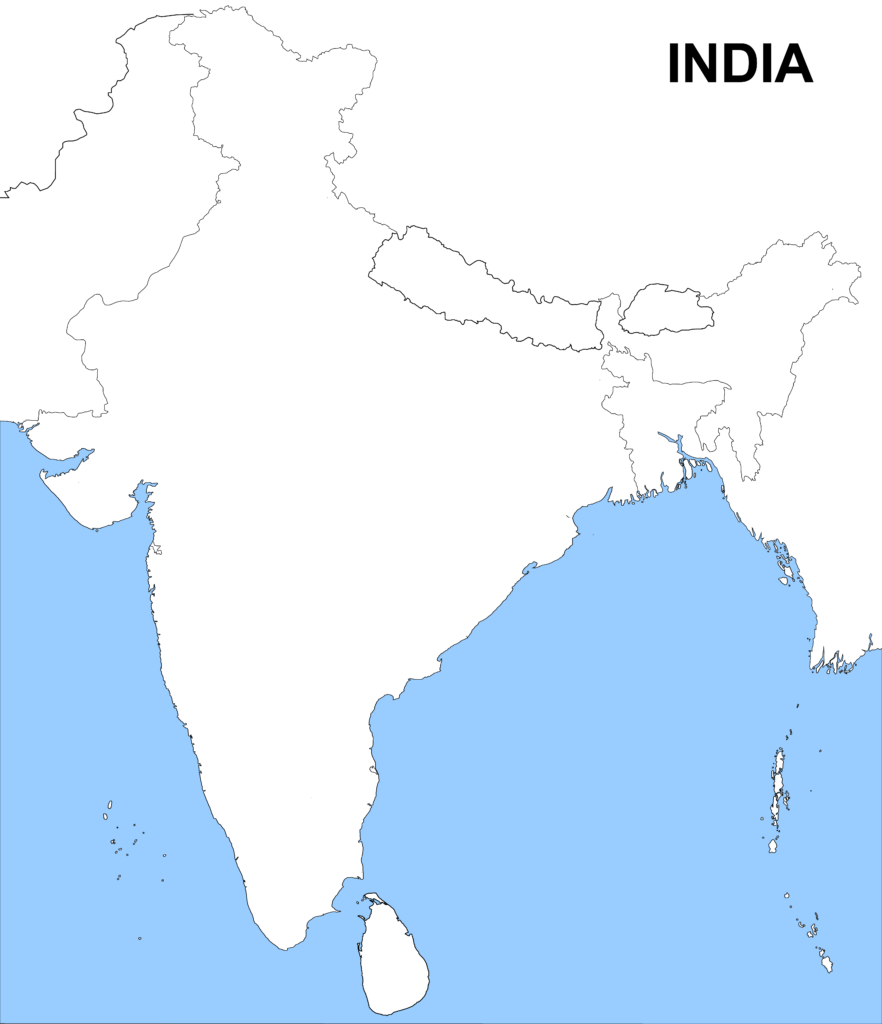
India Outline Map – Colourful
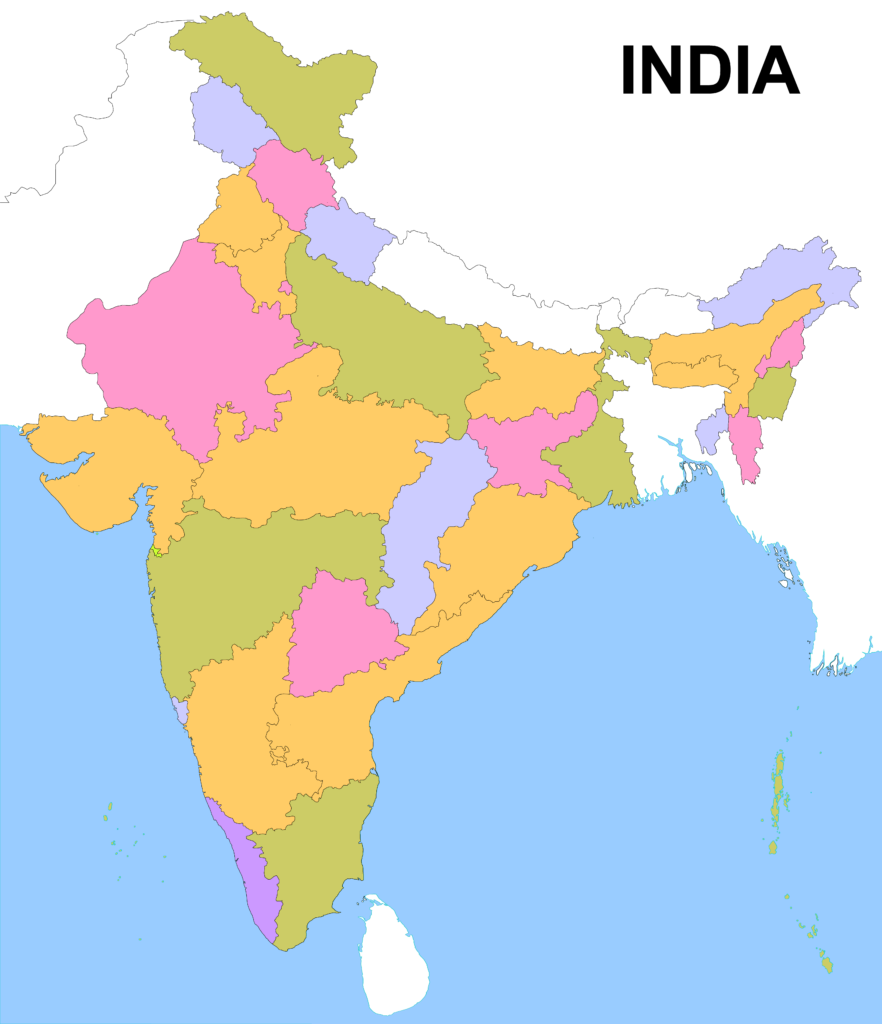
India River Map
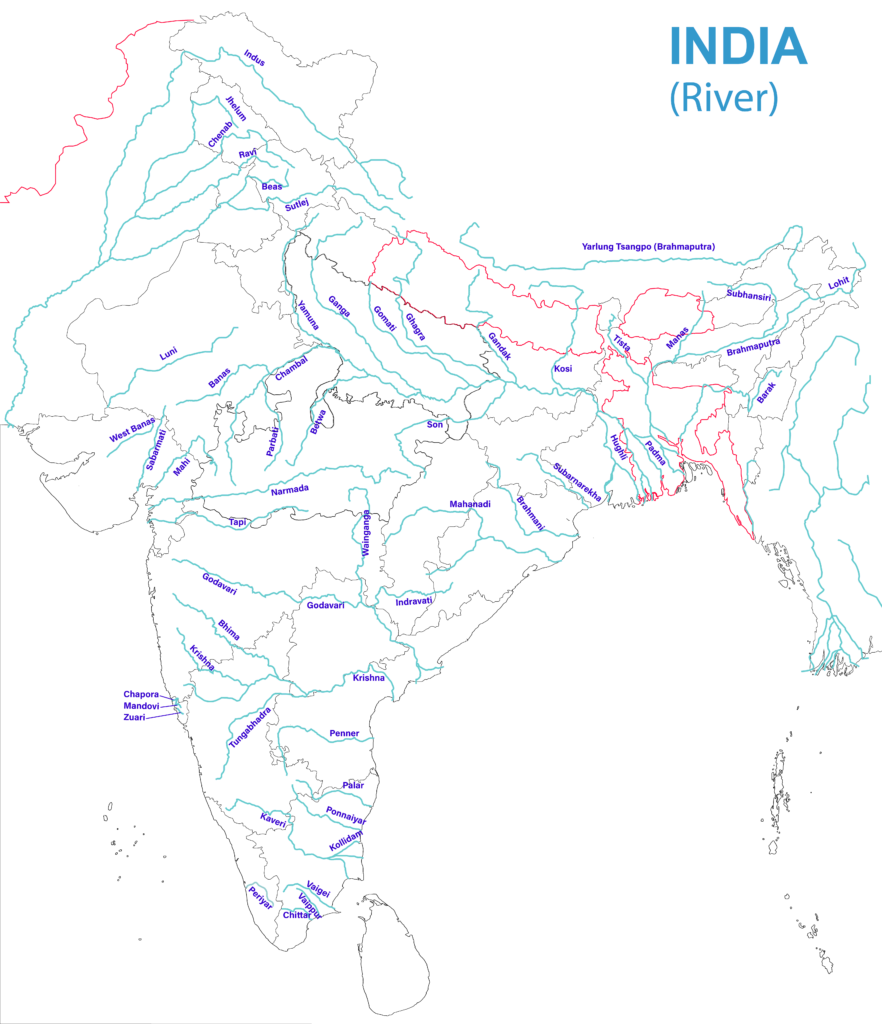
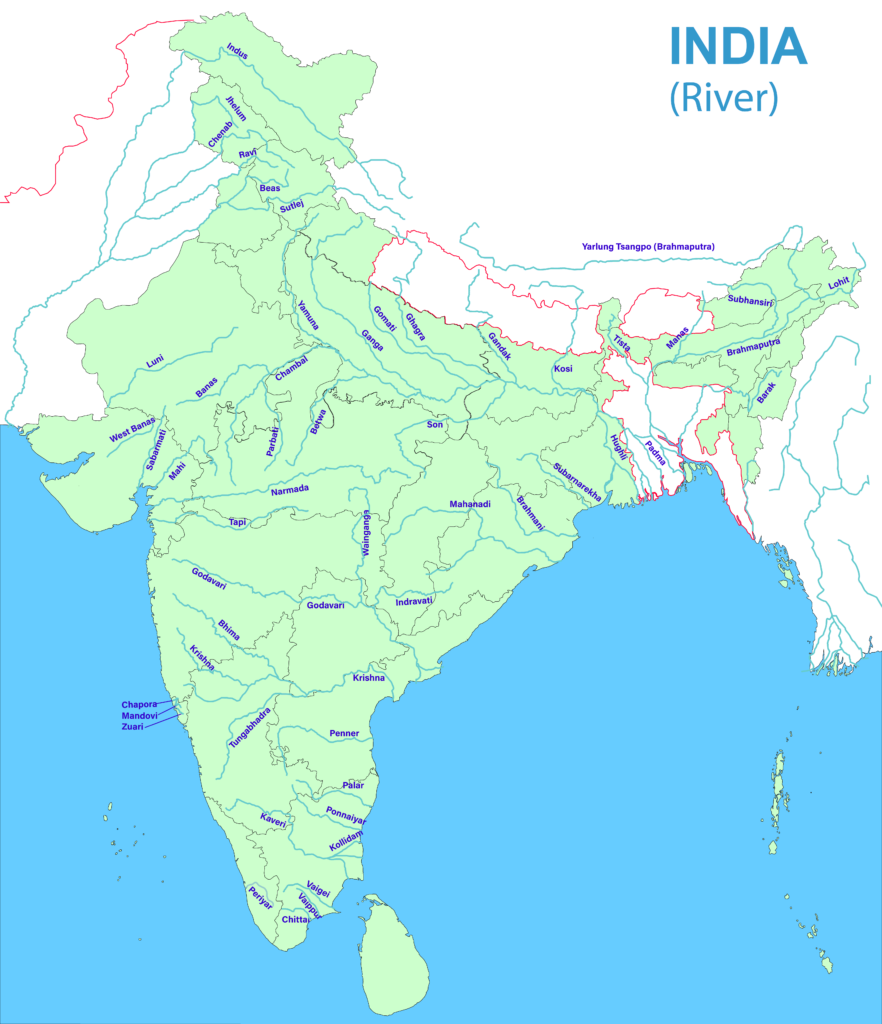
Bharat, that is India, officially the Republic of India (Bhārat Gaṇarājya), is a country in South Asia. It is the seventh-largest country by area; the most populous country as of June 2023; and from the time of its independence in 1947, the world’s most populous democracy. The new map of India depicts 28 states, 8 Union Territories that includes the National Capital Territory of Delhi.
Bounded by the Indian Ocean on the south, the Arabian Sea on the southwest, and the Bay of Bengal on the southeast, it shares land borders with Pakistan to the west; China, Nepal, and Bhutan to the north; and Bangladesh and Myanmar to the east. In the Indian Ocean, India is in the vicinity of Sri Lanka and the Maldives; its Andaman and Nicobar Islands share a maritime border with Thailand, Myanmar, and Indonesia.
Lying entirely in the northern hemisphere, the mainland extends between latitudes 8° 4′ and 37° 6′ north, longitudes 68° 7′ and 97° 25′ east and measures about 3,214 km from north to south between the extreme latitudes and about 2,933 km from east to west between the extreme longitudes. It has a land frontier of about 15,200 km. The total length of the coastline of the mainland, Lakshadweep Islands and Andaman & Nicobar Islands is 7,516.6 km. India covers an area of 32,87,263 sq. km, extending from the snow-covered Himalayan heights to the tropical rain forests of the south.
India is divided into 28 states and 8 union territories, each with its own capital city. The states and union territories are further divided into districts and subdivisions. The capital city of India is New Delhi, which is located in the National Capital Territory of Delhi. It is the administrative, political, and cultural center of the country.
The Jammu and Kashmir Reorganisation Act of 2019 designated October 31 as the designated day for the two Union Territories of J&K and Ladakh. It has never happened before for a state to be split into two Union Territories. With effect from January 26, 2020, India will have 8 union territories in addition to its 28 current states.
Since January 26th, the merger of Daman and Diu with Dadra and Nagar Haveli has formed a single union territory. This consolidation was carried out through a Bill passed in the winter session of Parliament, reducing the number of Union Territories to eight. Himachal Pradesh, Maharashtra, and Uttarakhand hold their legislative assemblies in different capital cities for their summer and winter sessions. Similarly, Ladakh has two administrative capitals, namely Leh and Kargil.
Capital of India
| Country | Capital |
|---|---|
| Bharat / India | New Delhi |
Complete list of 28 States and Capitals of India
| S.No | State | Capital |
|---|---|---|
| 1 | Andhra Pradesh | Amaravati |
| 2 | Arunachal Pradesh | Itanagar |
| 3 | Assam | Dispur |
| 4 | Bihar | Patna |
| 5 | Chhattisgarh | Raipur |
| 6 | Goa | Panaji |
| 7 | Gujarat | Gandhinagar |
| 8 | Haryana | Chandigarh |
| 9 | Himachal Pradesh | Shimla |
| 10 | Jharkhand | Ranchi |
| 11 | Karnataka | Bengaluru |
| 12 | Kerala | Thiruvananthapuram |
| 13 | Madhya Pradesh | Bhopal |
| 14 | Maharashtra | Mumbai |
| 15 | Manipur | Imphal |
| 16 | Meghalaya | Shillong |
| 17 | Mizoram | Aizawl |
| 18 | Nagaland | Kohima |
| 19 | Odisha | Bhubaneswar |
| 20 | Punjab | Chandigarh |
| 21 | Rajasthan | Jaipur |
| 22 | Sikkim | Gangtok |
| 23 | Tamil Nadu | Chennai |
| 24 | Telangana | Hyderabad |
| 25 | Tripura | Agartala |
| 26 | Uttar Pradesh | Lucknow |
| 27 | Uttarakhand | Dehradun |
| 28 | West Bengal | Kolkata |
Complete list of 8 Union Territories
| S.No | Union Territories | Capital |
|---|---|---|
| 1 | Andaman and Nicobar Island | Port Blair |
| 2 | Chandigarh | Chandigarh |
| 3 | Dadra and Nagar Haveli and Daman and Diu | Daman |
| 4 | Delhi | Delhi |
| 5 | Ladakh | NA |
| 6 | Lakshadweep | Kavaratti |
| 7 | Jammu and Kashmir | NA |
| 8 | Puducherry | Pondicherry |
Geographical information about India
| Location | The Indian peninsula is separated from mainland Asia by the Himalayas. The Country is surrounded by the Bay of Bengal in the east, the Arabian Sea in the west, and the Indian Ocean to the south. |
| Geographic Coordinates | Lying entirely in the Northern Hemisphere, the Country extends between 8° 4′ and 37° 6′ latitudes north of the Equator, and 68° 7′ and 97° 25′ longitudes east of it. |
| Indian Standard Time | GMT + 05:30 |
| Area | 3.3 Million sq. km |
| Telephone Country Code | +91 |
| Border Countries | Afghanistan and Pakistan to the north-west; China, Bhutan and Nepal to the north; Myanmar to the far east; and Bangladesh to the east of West Bengal. Sri Lanka is separated from India by a narrow channel of sea, formed by Palk Strait and the Gulf of Mannar. |
| Coastline | 7,516.6 km encompassing the mainland, Lakshadweep Islands, and the Andaman & Nicobar Islands. |
| Climate | The climate of India can broadly be classified as a tropical monsoon one. The Indian Meteorological Department (IMD) designates four official seasons: 1. Winter, from December to early April 2. Summer or pre-monsoon, from April to June (April to July in north-western India) 3. Monsoon or rainy, from June to September 4. Post-monsoon, from October to December |
| Terrain | The mainland comprises of four regions, namely the great mountain zone, plains of the Ganga and the Indus, the desert region, and the southern peninsula. |
| Natural Resources | Coal, iron ore, manganese ore, mica, bauxite, petroleum, titanium ore, chromite, natural gas, magnesite, limestone, arable land, dolomite, barytes, kaolin, gypsum, apatite, phosphorite, steatite, fluorite, etc. |
| Natural Hazards | Monsoon floods, flash floods, earthquakes, droughts, and landslides. |
| Environment – Current Issues | Air pollution control, energy conservation, solid waste management, oil and gas conservation, forest conservation, etc. |
| Environment – International Agreements | Rio Declaration on environment and development, Cartagena Protocol on biosafety, Kyoto Protocol to the United Nations Framework Convention on climatic change, World Trade Agreement, Helsinki Protocol to LRTAP on the reduction of sulphur emissions of nitrogen oxides or their transboundary fluxes (Nox Protocol), and Geneva Protocol to LRTAP concerning the control of emissions of volatile organic compounds or their transboundary fluxes (VOCs Protocol). |
| Geography – Note | India occupies a major portion of the south Asian subcontinent. |
Information about Indian Citizens
| Population | India’s population, as on 1 March 2011 stood at 1,210.9 million (623.2 million males and 587.6 million females) |
| Population Growth Rate | The average annual exponential growth rate stands at 1.64 per cent during 2001-2011 |
| Birth Rate | The Crude Birth rate was 20.1 during 2011-15 |
| Death Rate | The Crude Death rate was 7.2 during 2011-15 |
| Life Expectancy Rate | 65.8 years (Males); 68.1 years (Females) in the period 2006-2011 |
| Sex Ratio | 940 according to the 2011 census |
| Nationality | Indian |
| Ethnic Groups | All the five major racial types – Australoid, Mongoloid, Europoid, Caucasian, and Negroid find representation among the people of India. |
| Religions | According to the 2001 census, out of the total population of 1,028 million in the Country, Hindus constituted the majority with 80.5%, Muslims came second at 13.4%, followed by Christians, Sikhs, Buddhists, Jains, and others. |
| Languages | There are 22 different languages that have been recognised by the Constitution of India, of which Hindi is an Official Language. Article 343(3) empowered Parliament to provide by law for continued use of English for official purposes. |
| Literacy | According to the provisional results of the 2011 census, the literacy rate in the Country stands at 74.04 per cent, 82.14% for males and 65.46% for females. |
Information about Indian Government
| Country Name | Republic of India; Bharat Ganrajya |
| Government Type | Sovereign Socialist Democratic Republic with a Parliamentary system of Government. |
| Capital | New Delhi |
| Administrative Divisions | 28 States and 8 Union Territories. |
| Independence | 15th August 1947 (From the British Colonial Rule) |
| Constitution | The Constitution of India came into force on 26th January 1950. |
| Legal System | The Constitution of India is the fountain source of the legal system in the Country. |
| Executive Branch | The President of India is the Head of the State, while the Prime Minister is the Head of the Government, and runs office with the support of the Council of Ministers who form the Cabinet Ministry. |
| Legislative Branch | The Indian Legislature comprises of the Lok Sabha (House of the People) and the Rajya Sabha (Council of States) forming both the Houses of the Parliament. |
| Judicial Branch | The Supreme Court of India is the apex body of the Indian legal system, followed by other High Courts and subordinate Courts. |
| Flag Description | The National Flag is a horizontal tricolour of deep saffron (kesaria) at the top, white in the middle, and dark green at the bottom in equal proportion. At the centre of the white band is a navy blue wheel, which is a representation of the Ashoka Chakra at Sarnath. |
| National Days | 26th January (Republic Day) 15th August (Independence Day) 2nd October (Gandhi Jayanti; Mahatma Gandhi’s Birthday) |
